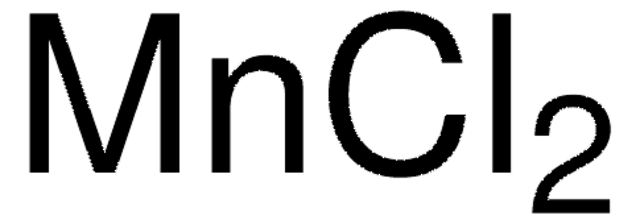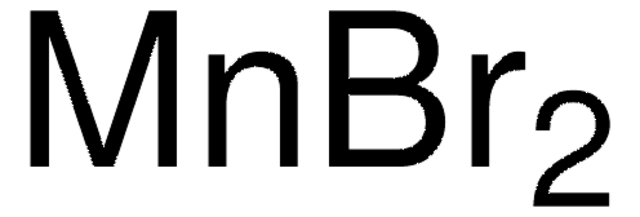244589
Manganese(II) chloride
powder and chunks, ≥99% trace metals basis
Synonym(s):
Manganese dichloride, Sacchite
About This Item
Recommended Products
grade
for analytical purposes
Quality Level
Assay
≥99% trace metals basis
form
powder and chunks
impurities
≤10000.0 ppm Trace Metal Analysis
mp
652 °C (lit.)
density
2.98 g/mL at 25 °C (lit.)
application(s)
battery manufacturing
SMILES string
Cl[Mn]Cl
InChI
1S/2ClH.Mn/h2*1H;/q;;+2/p-2
InChI key
GLFNIEUTAYBVOC-UHFFFAOYSA-L
Looking for similar products? Visit Product Comparison Guide
Related Categories
General description
Application
- As a precursor to synthesize manganese oxide nanoparticles.
- To fabricate Mn(ll) coordinated polyaniline electrodes for supercapacitors.
- To prepare thermally activated high anodic capability MOFs for Li-ion batteries.
- As a starting material to synthesize polymer composite films withenhanced optical properties.
Signal Word
Danger
Hazard Statements
Precautionary Statements
Hazard Classifications
Acute Tox. 3 Oral - Eye Dam. 1 - STOT RE 2
Target Organs
Brain
Storage Class Code
6.1D - Non-combustible acute toxic Cat.3 / toxic hazardous materials or hazardous materials causing chronic effects
WGK
WGK 2
Flash Point(F)
Not applicable
Flash Point(C)
Not applicable
Personal Protective Equipment
Choose from one of the most recent versions:
Already Own This Product?
Find documentation for the products that you have recently purchased in the Document Library.
Customers Also Viewed
Articles
Lithium-Ion Battery Performance: Dependence on Material Synthesis and Post‑Treatment Methods
Global Trade Item Number
| SKU | GTIN |
|---|---|
| 244589-250G | 4061833605752 |
| 244589-10G | 4061825760087 |
| 244589-1KG | |
| 244589-50G | 4061825760094 |
Our team of scientists has experience in all areas of research including Life Science, Material Science, Chemical Synthesis, Chromatography, Analytical and many others.
Contact Technical Service









